0.3 Bloom’s taxonomy
All topics in this course have learning objectives, which are given “K” levels to indicate the level of knowledge required. These are based on Bloom’s taxonomy of knowledge in the cognitive domain (ref Taxonomy of Educational Objectives, Handbook 1 – The Cognitive Domain, Bloom et al., New York 1956), illustrated below:

It is important to understand what you should take away from this course. Here, the learning objectives support the business outcomes and are used to create the examination for achieving the Certified Tester Foundation Level—Agile Tester Certification. In general, all parts of this syllabus are examinable at a K1 level. That is, the candidate will recognize, remember, and recall a term or concept. There are also some specific learning objectives at K2 and K3 levels, which are shown at the beginning of the relevant sections.
Remember (K1)
You must recognise, remember and recall a term or concept.
Understand (K2)
You are able to select the reasons, or explanations for, statements related to the topic and can summarise, compare, classify and give examples for the concept.
Apply (K3)
You are able to assess quality risks in a project, select a design technique to meet a purpose, practice a role, estimate the effort for a piece of work.
For this course, the overall learning objectives are:
- To ensure that the terminology used to describe Agile testing is understood and can be recalled and used appropriately.
- To be able to explain the concepts, approach and content of testing in Agile methodologies and to be able to apply them in the context of an organisation’s test process.
